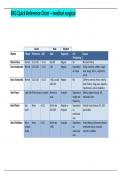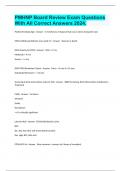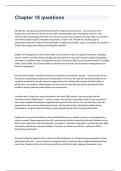- Acids = proton (H+) donors = partially dissociate into ions in solution
- Bases = proton (H+) acceptors CH3COOH(aq)⇌ CH3COO-(aq) + H+(aq)
Conjugate acid-base pairs = 2 species that Assumptions:
differ by H+ - [CH3COOH]i = [CH3COOH]eqm
E.g HA + H2O ⇌ A- + H3O+ - [CH3COO-]=[H+]
- Pair 1 = HA ⇌ A- Equations:
- Pair 2 = H2O ⇌ H3O+ - Ka = [CH3COO-][H+] = [H+]^2
pH of strong acids: [CH3COOH] [CH3COOH]
= completely dissociate into ions in - pH = -log10[H+]
solution At half neutralization point, pKa = pH
HA(aq) → H+(aq) + A-(aq) pH of buffers:
= Strong acids start flat
When pH is neutral [H+] = [OH-] Equations:
= Weak acids start with a flick
Assumptions: - Ka = [CH3COO-][H+]
Finding out where pH rise is:
- [HA]=[H+] - full dissociation [CH3COOH]
E.g. 10cm^3 of 0.2moldm^-3 HNO3
- Or [H2A]=[H+]/2 - pH = -log10[H+]
and 50cm^3 of 0.05moldm^-3 NaOH
Equations: - Find conc of each thing using Ci x Vi
Base is being added ∴ find volume
- pH = -log10[H+] Vtot
of base needed to neutralize acid
pH of strong bases: Assumptions:
HNO3 + NaOH
=completely dissociate into ions in solution - [CH3COONa]=[CH3COO-]
C= 0.2 0.05
BOH(aq) →B+(aq) + OH-(aq) - [CH3COOH] = conc of acid
X4
When pH is neutral [H+] = [OH-] pKa and pKw:
∴v(HNO3) x4 = v(NaOH) needed
Assumptions: pKa = shows how weak or strong an acid
= 10x4=40cm^3
- [MOH]=[OH-] is, lower pKa = stronger acid
Choosing an indicator:
Equations: pKw = the negative logarithm of the ionic
Changes colour within the pH range
- Kw = [H+][OH-] Kw=1x10^-14 product of water (Kw)
of the vertical section of the curve.
- pH = -log10[H+] Titration curves:
Hard to find for weak acids/bases -
pH of water: Equivalence point = when you get a
no vertical section.
Assumptions: neutral solution [OH-]=[H+]
- [H+] = [OH-] End point = indicator colour change
Equations: Titrations assume end point = equivalence
- Kw = [H+][OH-] point
- pH = -log10[H+]











